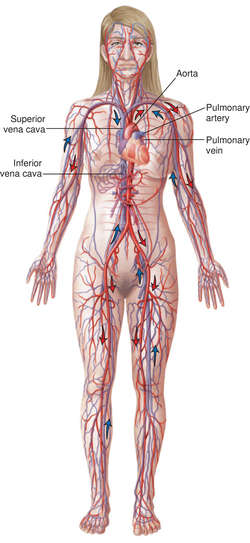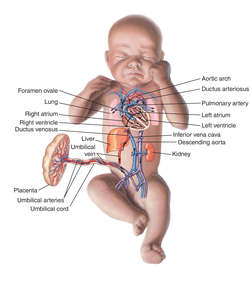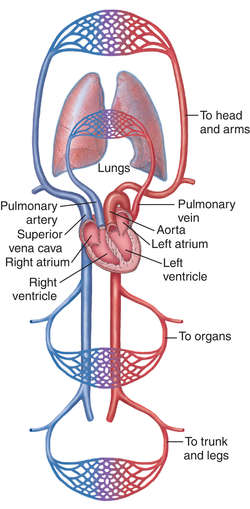Medical term:
circulation
cir·cu·la·tion
(ser'kyū-lā'shŭn),Movements in a circle, or through a circular course, or through a course that leads back to the same point; usually referring to blood circulation, but can apply to other commodities such as bile salts.
[L. circulatio]
Farlex Partner Medical Dictionary © Farlex 2012
circulation
(sûr′kyə-lā′shən)n.
1. Movement in a circle or circuit, especially the movement of blood through bodily vessels as a result of the heart's pumping action.
2.
a. Movement or passage through a system of vessels, as of water through pipes; flow.
b. Free movement or passage.
3. The passing of something, such as money or news, from place to place or person to person.
4.
a. The condition of being passed about and widely known; distribution.
b. Dissemination of printed material, especially copies of newspapers or magazines, among readers.
c. The number of copies of a publication sold or distributed.
The American Heritage® Medical Dictionary Copyright © 2007, 2004 by Houghton Mifflin Company. Published by Houghton Mifflin Company. All rights reserved.
circulation
Medtalk Blood stream. See Enterohepatic recirculation, Fetal circulation, Pulmonary circulation, Systemic circulation.McGraw-Hill Concise Dictionary of Modern Medicine. © 2002 by The McGraw-Hill Companies, Inc.
cir·cu·la·tion
(sĭr'kyū-lā'shŭn)Movements in a circle, or through a circular course, or through a course that leads back to the same point; usually referring to blood circulation through the network of arteries and veins unless otherwise specified.
[L. circulatio]
Medical Dictionary for the Health Professions and Nursing © Farlex 2012
circulation
(sir?kyu-la'shon) [L. circulatio, encirclement]Movement in a regular or circular course.
arterial circulation
Movement of blood through the arteries. It is maintained by the pumping of the heart and influenced by the elasticity and extensibility of arterial walls, peripheral resistance in the areas of small arteries, and the quantity of blood in the body.
assisted circulation
Use of a mechanical device to augment or replace the action of the heart in pumping blood.
bile salt circulation
Secretion and reuptake of the sodium glycocholate and taurocholate found in hepatic bile. Bile salts enter the duodenum and emulsify fats in the small intestine. They are resorbed in the terminal ileum and returned to the liver in portal blood.
blood circulation
The movement of blood through the left atrium and ventricle of the heart, aorta, arteries, arterioles, capillaries, venules, veins, vena cava, and back to the right side of the heart, into the pulmonary artery, lungs, and left side of the heart again.
See: artery; heart; circulatory system; veinBroca's circulation
See: Broca, Pierre-Paulcollateral circulation
Circulation established through an anastomosis between two vessels supplying or draining two adjacent vascular areas. This enables blood to bypass an obstruction in the larger vessel that supplies or drains both areas or enables blood to flow to or from a tissue when the principal vessel involved is obstructed.

CIRCULATION OF BLOOD THROUGH HEART AND MAJOR VESSELS
coronary circulation
Movement of blood through the vessels of the heart, specifically from the ascending aorta to the epicardial coronary arteries to the penetrating arteries of the myocardium, the coronary arterioles, capillaries, veins, coronary sinus, and into the right atrium. A few of the small veins open directly into the atria and ventricles.
See: illustrationenterohepatic circulation
Circulation in which substances secreted by the liver pass into the intestines where some are absorbed into the bloodstream and returned to the liver and re-secreted. Bile and bile salts follow this pathway.
extracorporeal circulation
Circulation of blood outside the body. This may be through an artificial kidney or a heart-lung device.

FETAL CIRCULATION

FETAL CIRCULATION: Vessels that carry oxygenated blood are red
fetal circulation
The course of the flow of blood in a fetus. Oxygenated in the placenta, blood passes through the umbilical vein and ductus venosus to the inferior vena cava and thence to the right atrium. It then follows one of two courses: through the foramen ovale to the left atrium and thence through the aorta to the tissues, or through the right ventricle, pulmonary artery, and ductus arteriosus to the aorta and thence to the tissues. In either case the blood bypasses the lungs, which do not function before birth. Blood returns to the placenta through the umbilical arteries, which are continuations of the hypogastric arteries. At birth or shortly after, the ductus arteriosus and the foramen ovale close, establishing the postpartum circulation. If either fails to close, the baby may be hypoxemic.
See: illustration; patent ductus arteriosusillustrationhypophyseal circulation
Superior and inferior hypophyseal arteries (slender branches from arteries of the circle of Willis) that provide blood to the pituitary gland and adjacent regions of the hypothalamus. Venous blood from the pituitary gland drains into the cavernous sinuses and, from there, into the internal jugular veins. Some of the superior hypophyseal arteries form primary capillary beds in the hypothalamus and the veins draining those beds ramify again to form secondary capillary beds in the adenohypophysis (anterior lobe of the pituitary), thus forming a portal circulation (the hypothalamic-pituitary portal circulation). Releasing factors secreted from the hypothalamus into the primary capillary beds reach the adenohypophysis via the secondary capillary beds.
lymph circulation
The flow of lymph from the tissues into the lymphatic collecting system. Lymph is formed from the tissue fluid that fills the interstitial spaces of the body. It is collected into lymph capillaries, which carry the lymph to the larger lymph vessels. These converge to form one of two main trunks, the right lymphatic duct and the thoracic duct. The right lymphatic duct drains the right side of the head, neck, and trunk and the right upper extremity; the thoracic duct drains the rest of the body. The thoracic duct originates at the cisterna chyli, which receives the lymphatics from the abdominal organs and legs. It courses upward through the diaphragm and thorax and empties into the left subclavian vein near its junction with the left interior jugular vein. The right lymphatic duct empties into the right subclavian vein. Along the course of lymph vessels are lymph nodes, which remove bacteria and other foreign materials, thus preventing their entrance into the bloodstream. Lymph flow is maintained by a difference in pressure at the two ends of the system. Important accessory factors aiding lymph flow are breathing movements and muscular activity.
persistent fetal circulation
Abbreviation: PFCA condition of newborns in which unoxygenated blood is shunted from the right to the left side of the heart through the ductus arteriosus and the foramen ovale, resulting in hypoxemia. It is caused by pulmonary hypertension and occurs most frequently in small-for-gestational-age infants and infants of diabetic mothers.

HEPATIC PORTAL CIRCULATION
portal circulation
1. Blood flow from the abdominal organs that passes through the portal vein, the sinusoids of the liver, and into the hepatic vein before returning to the heart from the inferior vena cava. This pathway permits the liver to process and to detoxify substances entering the body from the gastrointestinal tract.
2. A portal system between the hypothalamus and the anterior pituitary gland. The hypothalamus secretes releasing or inhibiting hormones into the blood; they are carried directly to the anterior pituitary and stimulate or inhibit secretion of specific hormones.
See: Hepatic Portal Circulation illustrationpulmonic circulation
An obsolete term for the pulmonary circulation.

PULMONARY CIRCULATION
pulmonary circulation
The flow of blood from the right ventricle of the heart to the lungs for exchange of oxygen and carbon dioxide in the pulmonary capillaries, then through the pulmonary veins to the left atrium. See: illustration

SYSTEMIC CIRCULATION
systemic circulation
The blood flow from the left ventricle through the aorta and all its arteries to the capillaries of the tissues and its return to the heart through veins and the venae cavae, which empty into the right atrium. See: illustration
venous circulation
Circulation via the veins.
vitelline circulation
The embryonic circulation of blood to the yolk sac via the vitelline arteries and its return to general circulation through the vitelline veins.
illustrationMedical Dictionary, © 2009 Farlex and Partners
circulation
Movement in a circle or around a circuit, especially the movement of the blood through the arteries, capillaries and veins, as a result of the pumping action of the heart.Collins Dictionary of Medicine © Robert M. Youngson 2004, 2005
cir·cu·la·tion
(sĭr'kyū-lā'shŭn)Movements in a circle, or through a circular course, or through a course that leads back to the same point.
[L. circulatio]
Medical Dictionary for the Dental Professions © Farlex 2012
Latest Searches:
actinomycomata - acthib - acrospire - acrosin - acroscleroderma - acromiothoracic - acromioplasty - acrobystiolith - acrisorcin - AcQtrack - acorea - acoflex - acochoerus - acidogenic - acidity - acidimetries - acidimeter - achillotenotomy - achillodynia - acetylization -
- Service manuals - MBI Corp